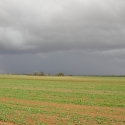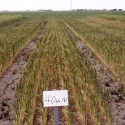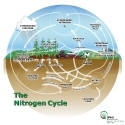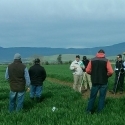21 Jun 2011
Nitrogen topdress strategies for canola - 2011
Selecting the right rate and product for topdresssing canola in 2011.
Nitrogen topdress strategies for canola - 2011
Last season showed the potential of canola under favourable conditions with many crops achieving 3 t/ha or better. With water filled soil profiles under this year’s crops, growers have another opportunity for this crop to shine. A key to using the water available efficiently is to ensure good nutrition, especially nitrogen.
The wet conditions caused leaching and denitrification of N in some soils and many paddocks will have low soil N tests. Canola can also be damaged by urea when applied with the seed in the sowing row.
As a result, now is the time to check if additional nitrogen is required to achieve the target yield.
What is the right time?
By the 4-6 leaf stage, a canola crop will take up between 50 and 70 kg N (Evans et al. 2003). Nitrogen supply from the soil mineral nitrogen and at-planting applied nitrogen will need to meet this demand.
But the good news is that even with moderate nitrogen supply early in the crops growth, canola can recover from N stress even up until buds visible (Hocking, 1987). Peak N demand will occur soon after this during stem elongation, so ensuring a good N supply by the start of this growth stage is important.
What is the right rate?
A simple nutrient budget can assist when determining the right fertilizer rate. Nitrogen removal by canola is around 40 kg per tonne of grain, and nitrogen use efficiency is usually 40 to 50%. Although it may be a shock, a crop with a 3 t/ha target yield will need to be supplied with between 240 and 300 kg N per hectare.
With a 50 kg N soil test and a further 40 kg N supplied from mineralization of organic matter during the season, the 3 t/ha canola crop will need to be supplied with an additional 150 to 200 kg N to meet its potential.
How to test for Nitrogen
There are several strategies to check the nitrogen requirements of canola in-crop.
Plant Tests
Whole plant N content varies with growth stage and tends to be around 6% early. However the test is less sensitive to N supply than a either leaf nitrate or total leaf N tests. Critical values vary with growth stage (Table 1) as well as sowing time and probably variety, so these tests need careful interpretation to determine if the crop is likely to benefit from extra N.
Table 1 Critical nitrate N concentrations for Canola reported in the literature
| Test | 5-6 leaf stage | Buds Visible | Start Flowering | Source |
| Critical nitrate-N in fresh youngest mature leaves (mg/g Fresh Weight) | 1.6 to 1.7 | 0.50 to 0.70 | 0.06 to 0.14 | Bernadi & Banks (1993) Hocking (1993), Hocking et al. (1997) |
| Critical total N concentration in youngest mature lamina (%Dry Weight) | 6.8 to 7.1 | 5.9 | 5.3 | Hocking (1993), Hocking et al. (1997) |
Test Strips
Early topdressing a small, but typical, area of the paddock can give an indication of potential responses. In a 10 by 10 m block, hand spread 2.3 kg of urea soon after emergence – this is equivalent to 100 kg N/ha. If this patch is still showing up by 4-6 leaf stage then it is likely the whole paddock could use additional N.
Even though the season looks good, splitting the N over a two topdressings may be a good strategy to reduce the risk of a poor finish. Adding N as the yield potential unrolls up until stem elongation occurs is a sound risk management strategy.
What is the right N source?
Urea is generally the cheapest source of N, but it relies on rain within a few days to be most efficient. This is because some N can be lost as ammonia. Losses are most common on dry soils with warm temperatures. Under these conditions, a urease inhibitor can increase fertilizer efficiency significantly. For example, where 80 kg of N was topdressed as urea, the cumulative ammonia loss over 24 days was reduced from 8 to less than 1 kg N where a urease inhibitor was used (Turner et al. 2009).
The fluid N source urea ammonium nitrate can also be a good option. Application needs to be through streaming nozzles or dribble bars to reduce the risk of burn to the foliage.
If addition sulphur is required, then ammonium sulphate can be topdressed or the fluid fertilizer ammonium thiosulphate can be used, either alone or in combination with added urea to increase the N rate applied.
Figure 1: Canola growth stages.
Source: Dovuro, Australia's Canola Specialists.
References
Bernardi, A. L., and Banks, L. W. (1993). Petiole nitrate nitrogen; is it a good indicator of yield potential in irrigated canola. In ‘Proceedings of the 9th Australian Research Assembly on Brassicas’. Wagga Wagga. pp. 51–6.
Evan M, A McCutcheon, R Norton, S Marcroft (2003). Early nitrogen uptake in canola in 2001. In. "Solutions for a better environment". Proceedings of the 11th Australian Agronomy Conference, 2-6 Feb. 2003, Geelong, Victoria. Australia. http://www.regional.org.au/au/asa/2003/c/3/evans1.htm
Hocking, P. J. (1987). Effects of relief or onset of nitrogen stress at different growth stages on yield components of rapeseed. In ‘Proceedings of the 6th Australian Rapeseed Agronomists and Breeders Workshop’. Canberra. (Ed. R. N. Oram.) pp. 16–8.
Hocking, P. J. (1993). Effects of sowing time and plant age on critical nitrogen concentrations in canola (Brassica napus L.). Plant and Soil 155/156, 387–90.
Turner, D., R. Edis, D. Chen, B. White and R. Christie. 2009 Nitrogen loss from top-dressing fertilizers to wheat. University of Melbourne Progress Report.




